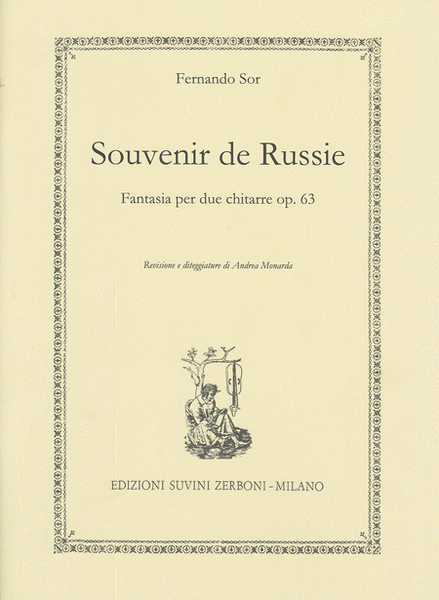Souvenir de Russie
per due chitarre
-
Ships in 2 to 3 weeks
Details
Description
SKU: BT.ESZ-01513700
Per due chitarre. Composed by Fernando Sor. Books on Music. Book and Part(s). Composed 2016. Edizioni Suvini Zerboni #ESZ 01513700. Published by Edizioni Suvini Zerboni (BT.ESZ-01513700).Fernando Sor (1778-1839) composed Souvenir de Russie, which has been dedicated to his beloved pupil Napoléon Coste, during the latter years of his life. Souvenir de Russie follows coherently the Sor’s compositional style of the 1830’s. His works composed around 1810 found in Mozart as well as in the Apollonian, a stylistic and formal ideal, whereas his works composed in the 1830’s show a new musical language, in which sentiments flow more easily, thanks to a formal concept less bound to the schemes of the XVIII century (R. Chiesa). Both Chopin and the years in which Sor lived in Russia (1823 1826) influenced the compositional style of Souvenir de Russie, which eventually tookinspiration from two Russian melodies. The first one, “ ” (“What have I done to upset you?”), is the theme on which the nine variations are based, whereas the second “ ” (“Along the gravel street”) provides the music material developed by Sor along the entire Allegretto. In this revision both the score and the separate parts have been bundled into one volume, differing from the previous editions as well as from the original one, in which only the separate parts can be found. Besides, the fingering explained into Sor’s Méthode pour la guitare and into the book Fernando Sor: The Complete Studies for the guitar, have been the models of the fingering proposed into this revision. For instance, the use of the anular of the right hand exclusively to pluck a chord with four voices or the use of the open string as pedal while changing position. The fingering has been printed not only on the separate parts, but also on the score, with the aim to provide a coherent idea of technique and timbre both for the single guitar as well as of the guitar duo.

 Share
Share